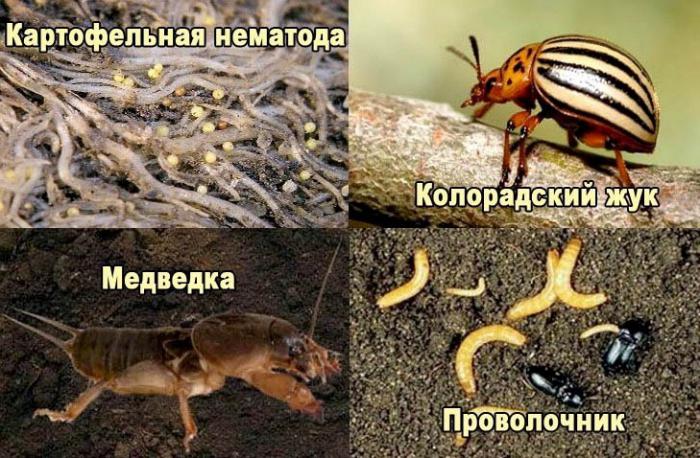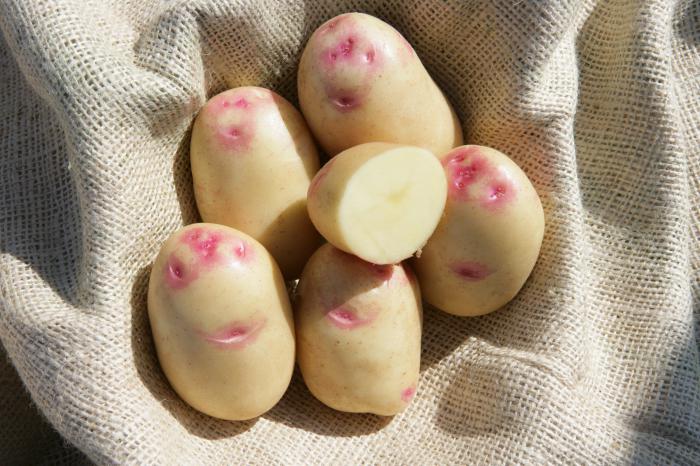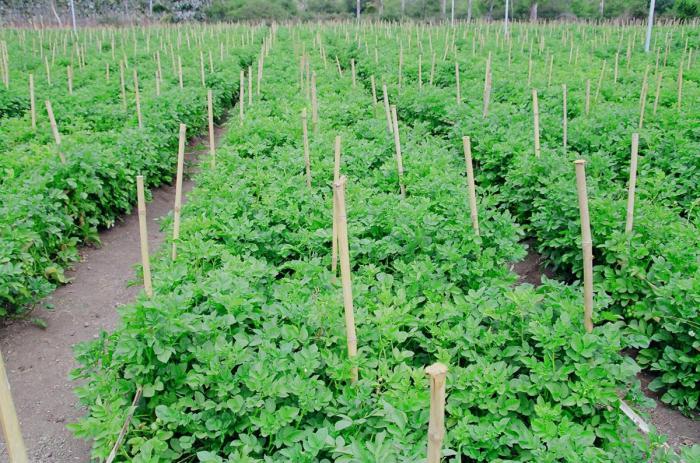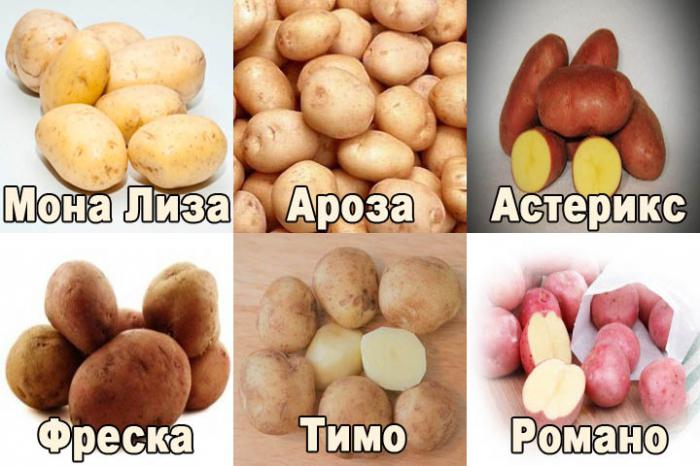Potato yield per 1 ha. Potato production technology. Varieties (photo)
The value of this plant for Russia is difficult to overestimate. Potato is the most consumed vegetable in our country. 120-130 kg per person per year is a significant figure, and we are second only to China in potato production. It is a strategic culture that successfully provides countries.
Potato growing in Russia
One of the features of our potato production is the predominance of traditionally characterized by low efficiency due to the high proportion of manual labor.
In recent years, large-scale potato production has been developing more and more actively, demonstrating much higher yields due to the possibility of applying technologies and science-based soil fertilization rates.
Another characteristic feature of recent years is the reduction in the area allocated for cultivation. But the increase in yield so far makes it possible to fully compensate for the decrease in planting area.
However, in order to catch up with developed countries, we will have to more than double the current yield. This is not easy as competition intensifies in agricultural markets and fuel prices rise rapidly.
In addition, as usual, the technical support of the industry is lagging behind. All this has led to the fact that the weakest producers leave, unable to withstand competition, and the remaining ones are forced to constantly think about increasing production efficiency.
Russia is the traditional leader in terms of gross potato production, producing 11% of the world harvest. At the same time, 70-80% of the raw product is used for personal consumption.
Industrial processing in Russia is very poorly developed, not exceeding a few percent. According to forecasts, the next redistribution of the potato market in Russia will be associated with the development of processing of this vegetable.
The main pests of potatoes
The Colorado potato beetle is one of the main potato pests. In small areas, they fight it manually, collecting beetles, pupae and larvae in a container with kerosene, formalin or a strong saline solution. In large areas, 80% dilor or chlorophos is used. The best time for chemical treatment is the beginning of reproduction of the second or third age of larvae.
Potato nematode often attacks potatoes. Its larvae harm both the roots and tubers of the plant. Nematode cysts are found in the ground, on the roots of potatoes, and contain 200-1000 eggs each. Outwardly, the plant looks sick, the lower leaves die off, the rest quickly wither. Cysts can remain viable for up to 10 years or more. In infected areas, quarantine measures are usually observed, legumes, cereals and vegetables are not cultivated for up to four years. Pest control also does not allow the use of contaminated seeds and implements that till the soil.

Wireworm - larvae of click beetles that damage roots and tubers. To combat it, they set up traps, creating small herbal piles in the garden. Beetles are collected in them, which are subsequently destroyed. Good weeding also helps, it is especially important to destroy the wheatgrass.
Potato pest control should be the focus of anyone who grows potatoes, otherwise you can lose the entire crop.
Profitability of the potato business
If you invest 80,000 rubles in production, you can get a potato yield of 20 tons per hectare. At the same time, only 7-8 tons can be harvested from the same wheat area, which will provide about 60-65 thousand rubles. arrived. In the case of the use of new technologies, the potato yield per 1 ha can reach 80 t/ha, and the income, respectively, - 800 thousand rubles!
Experts have calculated what is needed to grow 100-240% profitable potatoes. A business plan for its production should take into account a field area of at least 250 hectares, and financial investments - at the level of $ 7 million, and even working capital in the amount of $ 0.5-1 million. Over the past year, the profitability of this business in Russia amounted to 40-60 %.

According to the same experts, a potato growing project pays off in an average of 5-7 years, and the intermediate results are not always indicative. Throughout the entire period of activity, systematic and serious investments are needed. For example, the cost of a harvester is about 300 thousand euros, a planter costs 80 thousand euros, etc. Soviet technology is already outdated and can lead to damage to the crop.
But all this applies. For individual farms, there are schemes with a low level of investment, but also with a lower profitability.
Business plan for a home lot
The technology for the production of potatoes on a personal plot has its own characteristics. To begin with, let's try to calculate at least an approximate profitability of the potato business in these conditions. To do this, you need to analyze the estimated costs. Then it makes sense to calculate the amount of profit, taking into account the average potato yield per 1 ha and wholesale prices. After that, to obtain the value of net income, it is necessary to subtract the first from the second figure. An approximate calculation for a plot of 0.5 hectares will be as follows.
Thus, all preliminary expenses fit into the amount of 1.5 thousand dollars. With an average yield of 200 kg per hundred square meters and an average wholesale purchase price for potatoes of $0.2 per 1 kg, you can get $2,000 from sales in the first year. Since the equipment is not purchased for one year, then in subsequent years it is possible to have much more profitable potatoes. The price for it, as practice shows, is only growing.

Industrial methods of potato production
Potato production technology using modern methods has already made it possible today to significantly increase the efficiency of the potato industry. Now the next step is the use of industrial methods of its cultivation. This concept means the following principles.
- The volume of production is planned in advance, and the calculations justify themselves.
- All quality indicators are calculated and set before landing.
- The harvest is received in strict accordance with the planned dates.
All this is achieved by applying industrial methods, consisting of the following elements.
- Various organizational and technical improvements ensure high productivity, which as a result minimizes production costs.
- The active use of various technological methods makes it possible to almost cancel the influence of adverse weather conditions.
- Minimization of the impact of the human factor on the result of the production process through the use of technical means and methods.
- The high average yield of potatoes is achieved through the introduction of management tools and operational control. Technological methods also play an important role, allowing to ensure the planned amount of production.
Right now there is every opportunity to switch to industrial methods in potato growing. The following factors contribute to this:
- the market needs for a quality product are constantly growing;
- the number of workers in agriculture, as well as their skill level, is declining;
- the technology market enables the economy to acquire machines capable of implementing the application of the industrial method;
- the availability of advanced world technical achievements makes it possible to make a transition to a completely new level of potato cultivation.
The effectiveness of technical solutions should not depend on the size of the farm and its specifics. The solution of the complex task of switching to industrial methods should be implemented on the basis of the best domestic and foreign experience, as well as highly professional recommendations from specialists.
How to increase potato yield
There are many factors that affect the yield of potatoes. Some of them are listed below.

Application of fertilizers for potatoes
First of all, it is important to remember that during growth, potatoes draw about 50 kg of nitrogen, 20 kg of phosphorus and 90 kg of potassium from the ground per 10 tons of product. Therefore, it is these mineral fertilizers that should be regularly applied to the soil so that it does not become depleted and can provide the potatoes with the nutrition they need.
Nitrogen helps the active growth of the plant, the flow of carbohydrates into the tubers.
Phosphorus increases resistance to drought, develops the root system and accumulates starch in the tubers, contributing to their early ripening.
Potassium causes an increase in carbohydrates in tubers, increases resistance to weather conditions.
When fertilizing the soil, it is important to maintain the right balance. With a lack of potassium, for example, nitrogen is poorly absorbed. In addition, an excess of any fertilizer can be as harmful as a deficiency.
Apply organic fertilizers, although they double the yield, agronomists do not recommend because of the danger of infection with scab or ingestion. It is better to use peat-dung composts.
As a fertilizer for potatoes in the fall, it is recommended (1 kg per hundred square meters) and potassium sulfate (2 kg per hundred square meters).
In the spring, it is good to fertilize potatoes with urea and saltpeter (1 kg per hundred square meters). You can also use nitrophoska 5 kg per hundred square meters and nitroammofoska - 3 kg each.
Bone meal is an excellent form of fertilizer for potatoes in the fall, and it improves the taste of the product. And at this time it is useful to fertilize the earth with superphosphate and potato kemira, this universal potato fertilizer.
Of the natural feeds that are ideal for potatoes, wood ash should be called. In addition to feeding, it also protects against many diseases and decay. So it is best to start with ash and nitrophoska, and then look at the results. Too much fertilizer is bad for plants.
The best varieties of potatoes
For planting, it is better to take varietal tubers. They are more expensive than random ones, but they guarantee good taste and a healthy harvest.
At any summer cottage there are always early ripening potato bushes, which can be dug up from the middle of summer. Among the early varieties can be distinguished, such as Timo, Ariel, Lark, Bullfinch, Luck, as well as medium-early ones - Madam and Prize-winner.
The once popular white-fleshed cultivar Sineglazka has a low potential and is considered fodder in Europe.
For those who care about health, we can safely recommend such varieties as the Dutch Mona Lisa, Fresco, Romano, German Arosa, Rosara, Felox, Finnish Timo, Asterix. These varieties contain a lot of carotene, which improves eyesight.

And you can safely navigate to your taste. Scientists have found that tasty varieties contain much more amino acids, nucleotides and fatty acids!
In the competition for the best taste, such varieties as Borodyansky pink, Snegir, Adretta, Aurora, Golubyzna, Vesnyanka, Temp hold the championship.
It is worth highlighting the Zhukovsky variety. Potatoes are classified as early varieties that grow well at low temperatures. It is resistant to many diseases, has a smooth skin, has a long shelf life and tastes great.
Bellarosa potatoes, bred by German breeders, are recommended for cultivation in Eastern Europe. This is an early variety, it can be dug up already on the 45th day. It is very profitable: the yield of potatoes from 1 hectare is 400 centners!

The Bellarosa variety is almost not susceptible to pests, is not picky about moisture, is resistant to drought, grows on any soil, except for heavy clay soil, and is lossless during storage (93%). It has large even tubers, excellent taste and high friability.
How to properly store potatoes
When storing potatoes, it is very important to prevent the tubers from rotting or starting to sprout. Therefore, it is better to store it in a cold and dry room, which is well ventilated.
It is especially necessary to be careful in the spring, when the tubers lose their mass, their appearance worsens and the amount of vitamins decreases. During this period, potatoes should be monitored and checked regularly for spoilage.
The storage process of potatoes can be conditionally divided into 3 stages.
- For two weeks, keep in storage at t about +15 about. In this case, the tubers heal, and moisture partially leaves them.
- Until the end of winter, potatoes seem to “sleep”, the best temperature for storage is from 3 to 5 ° C.
- With the onset of spring, the tubers begin to prepare for germination. During this time, the storage temperature may be increased by several degrees.
The potato is the breadwinner
There are a number of steps that cannot be eliminated when growing potatoes. A business plan for its production on a small area (about 0.3 hectares) for your farm and sales on the market involves several stages.
First of all, it is necessary to prepare material for planting. Then it is necessary to carry out all the necessary preparatory work with the soil, only after that you can proceed to planting potatoes.
Then follow the stages of hilling and fertilization. It is also necessary to take care of protection against diseases and pests. Harvesting is also a difficult stage of work, after which there are two last steps: packaging and ensuring storage.
To do this, you need to have at least minimal equipment. This minimum includes, first of all, a mini-tractor. The kit must necessarily include a hiller and a plow. Of course, there must be a body for the tractor. Don't forget to get a digging device. It will need to be attached to a mini-tractor.
It is not bad to take into account one interesting detail: washed, dried and neatly packaged potatoes are sold on the market for about twice as much as dirty, hastily loaded into ordinary gray and unattractive bags.
Given this circumstance, you can seriously increase your income not only due to the packaging of your own potatoes. It is quite possible to organize packaging of beautifully prepared potatoes from other producers. You can, in principle, build your business on this.
For this, certain conditions must be met:
- availability of permanent water supply;
- large containers for washing potatoes;
- a place where it can be dried;
- large scales;
- packaging bags and labels for them.
Thus, you can organize your own potato business from scratch and make it profitable.
